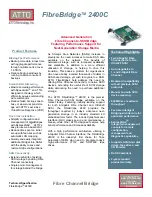
Fabric OS 6.2 administrator guide 293
13 Configuring the Distributed Management Server
Distributed Management Server overview
The Fabric OS Distributed Management Server (MS) allows a SAN management application to retrieve
information and administer interconnected switches, servers, and storage devices. The management server
assists in the autodiscovery of switch-based fabrics and their associated topologies.
A client of the management server can find basic information about the switches in the fabric and use this
information to construct topology relationships. The management server also allows you to obtain certain
switch attributes and, in some cases, modify them. For example, logical names identifying switches can be
registered with the management server.
The management server provides several advantages for managing a Fibre Channel fabric:
•
It is accessed by an external Fibre Channel node at the well-known address
FFFFFAh
, so an
application can access information about the entire fabric management with minimal knowledge of the
existing configuration.
•
It is replicated on every HP StorageWorks switch within a fabric.
•
It provides an unzoned view of the overall fabric configuration. This fabric topology view exposes the
internal configuration of a fabric for management purposes; it contains interconnect information about
switches and devices connected to the fabric. Under normal circumstances, a device (typically an FCP
initiator) queries the name server for storage devices within its member zones. Because this limited view
is not always sufficient, the management server provides the application with a list of the entire name
server database.
Platform services
The management server is located at the Fibre Channel address
FFFFFAh
. By default, all management
services except platform services are enabled; the MS platform service and topology discovery are
disabled.
Use the
msplMgmtActivate
and
msplMgmtDeactivate
commands to activate and deactivate the
platform services throughout the fabric. The
msplMgmtActivate
command attempts to activate the MS
platform service for each switch in the fabric. The change takes effect immediately and is committed to the
configuration database of each affected switch. MS activation is persistent across power cycles and
reboots.
Before issuing the
msplMgmtActivate
command, run the
msCapabilityShow
command to verify that
all switches in the fabric support the MS platform service; otherwise, the command will fail.
When FCS policy is enabled, the
msplMgmtActivate
command can be entered only from the primary
FCS switch.
The execution of the
msplMgmtActivate
command is subject to Admin Domain restrictions that may be
in place. See the
Fabric OS Command Reference
manual and see Chapter 1, ”
Performing basic
configuration tasks
” on page 29 and Appendix A, ”
Configuring the PID format
” on page 523
for details.
NOTE:
The commands
msplMgmtActivate
and
msplMgmtDeactivate
are allowed only in AD0
and AD255.
Platform services in a Virtual Fabric
Each Logical Switch has a separate Platform Database. All platform registrations done to a Logical Switch
are valid only in that particular Logical Switch’s Virtual Fabric.
Activating the platform service by entering the
msplMgmtActivate
command will activate platform
services on all Logical Switches in a Virtual Fabric. Similarly, entering the
msplMgmtDeactivate
command will deactivate the platform service on all Logical Switches in a Virtual Fabric. The
msPlatShow
command displays all platforms registered in a Virtual Fabric.
Содержание A7533A - Brocade 4Gb SAN Switch Base
Страница 1: ...HP StorageWorks Fabric OS 6 2 administrator guide Part number 5697 0016 Edition May 2009 ...
Страница 24: ...24 ...
Страница 99: ...Fabric OS 6 2 administrator guide 99 ...
Страница 100: ...100 Managing user accounts ...
Страница 118: ...116 Configuring standard security features ...
Страница 164: ...162 Configuring advanced security features ...
Страница 234: ...232 Installing and maintaining firmware ...
Страница 268: ...266 Administering advanced zoning ...
Страница 284: ...282 Configuring Enterprise class platforms ...
Страница 292: ...290 Routing traffic ...
Страница 294: ...292 Interoperability for merged SANs ...
Страница 302: ...300 Configuring the Distributed Management Server ...
Страница 334: ...332 iSCSI gateway service ...
Страница 340: ...338 Administering NPIV ...
Страница 407: ...Fabric OS 6 2 administrator guide 405 ...
Страница 408: ...406 Using the FC FC routing service ...
Страница 438: ...434 Administering extended fabrics ...
Страница 460: ...456 Administering ISL trunking ...
Страница 498: ...494 Configuring and monitoring FCIP extension services 556200 Bps 30s avg 491394 Bps lifetime avg ...
Страница 516: ...512 FICON fabrics ...
Страница 526: ...522 Configuring and monitoring FICON Extension Services ...
Страница 540: ...536 Configuring the PID format ...
Страница 544: ...540 Understanding legacy password behavior ...
Страница 546: ...542 Mixed fabric configurations for non merge SANs ...
Страница 550: ...546 Migrating from an MP Router to a 400 MP Router ...
Страница 558: ...554 Inband Management ...
Страница 572: ...568 ...















































